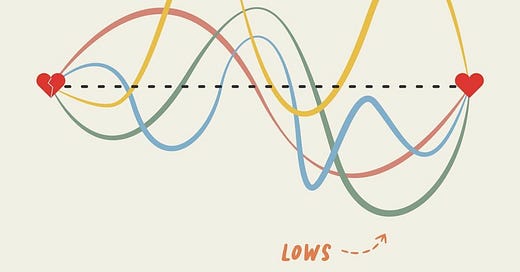Dear Friends,
Healing from trauma is rarely a straightforward journey. It's more like navigating a labyrinth than walking a straight path.
In trauma, we often develop coping mechanisms to navigate unstable environments. These behaviors, while protective initially, can disconnect us from our authentic selves. Fawning was how we navigated spaces where our needs weren’t welcome, where conflict felt dangerous, where being fully seen might have meant being rejected, punished, or abandoned. Over time, this survival strategy became second nature, leaving us disconnected from what we truly feel, need, and desire.
Unfawning Begins With Awareness
One of the biggest hurdles in unfawning is simply allowing ourselves to know what we feel. Not what someone else expects us to feel. Not what keeps the peace. Just the raw, unfiltered truth of our own emotions. For many, this step alone is terrifying—because it requires stepping out of the protective layers we built to keep ourselves safe.
If this resonates, ask yourself: Can I just feel the feeling? Not share it, not justify it, not act on it—just allow it to exist. Sometimes, breaking free from fawning isn’t about bold declarations or immediate change. It’s about making it safe to even acknowledge what’s there.
Making Sense of What’s Been Boxed Away
Often, the ways we fawn are not just about avoiding conflict—they are about avoiding ourselves. When we’ve spent years or even decades shaping ourselves around others, parts of who we are can feel tucked away, compartmentalized, or entirely inaccessible.
Instead of trying to dismantle these patterns all at once, what if we approached them with curiosity? Ask yourself: What parts of me feel like they are still in a box? What has been hidden—maybe even from myself?
Maybe it’s a creative pursuit you abandoned because someone dismissed it long ago.
Maybe it’s an opinion you never share, even when you feel strongly.
Maybe it’s a part of yourself you’ve learned to protect by keeping it quiet.
Honoring our survival strategies means recognizing why we placed these parts of ourselves in boxes in the first place. We did it to stay safe. But healing invites us to gently open those boxes, one at a time, with care and patience.
Reclaiming Ourselves, Piece by Piece
Unfawning isn’t just about setting boundaries or saying no. It’s about becoming real—allowing ourselves to exist fully, without secrecy or performance. It’s a process of stepping into our lives, moment by moment, with more authenticity.
If this resonates with you, I’d love to hear: What’s one small way you’ve reclaimed a part of yourself recently? Maybe it was using your voice in a new way, setting a limit, or allowing yourself to feel something without apologizing. If you’d like to share, email me at hello@ingridclayton.com comment below directly on this newsletter. And if you're open to me sharing your reflection with others in a future newsletter (anonymously or with your name), let me know—it may help someone else navigating the same thing.
Healing happens in steps. And with every small step, more light pours in.






So good Ingrid! I remember a few years ago when I took up a new hobby it being dismissed. Looking back to my childhood all hobbies were things that my parents liked. Anything new or different was given a little smirk of just being tolerated.
Thankyou Ingrid for this great share. Yesterday during my meditation I’d started to feel a lot of anger towards my late father. I just sat with the feeling and told myself “it’s OK to have this feeling. It’s OK” Afterwards Iwas curious as to why it had surfaced but didn’t question it too closely. I will wait and see what develops. It’s a relief not to have to take action every time I feel bad. Just note it with interest and see where it takes me. I am more patient with myself these days.